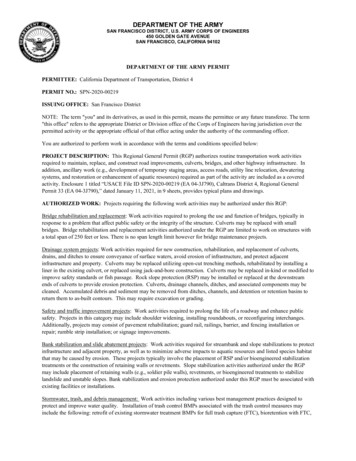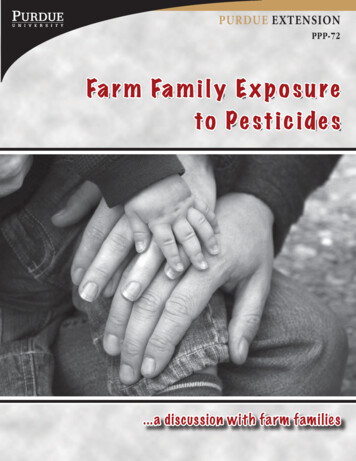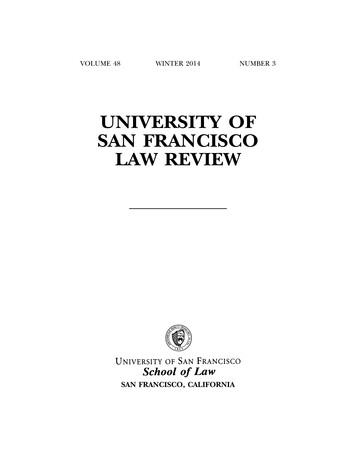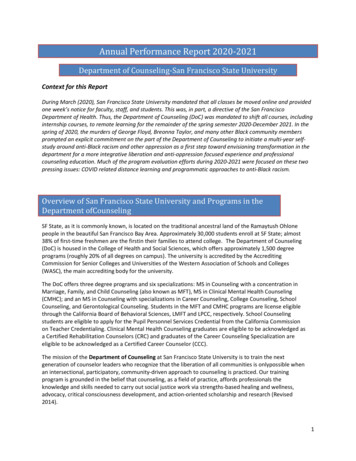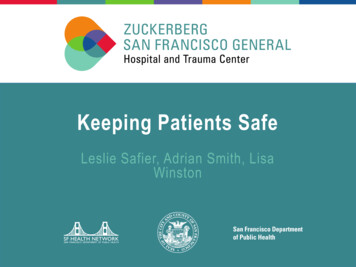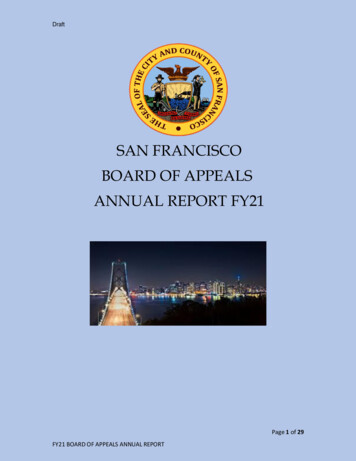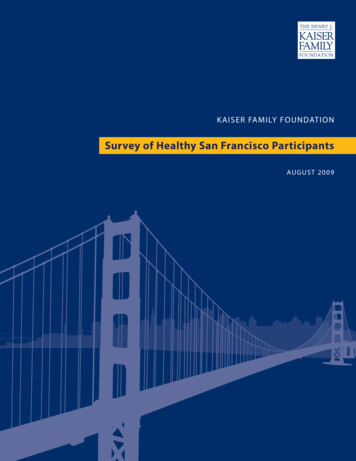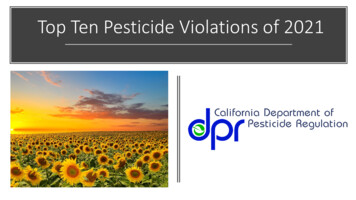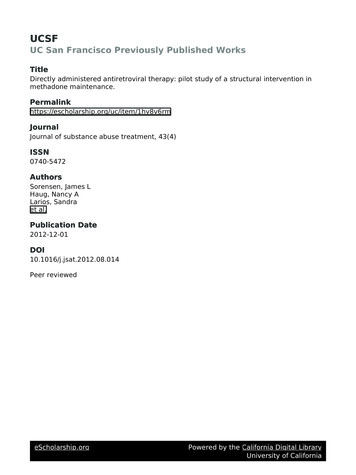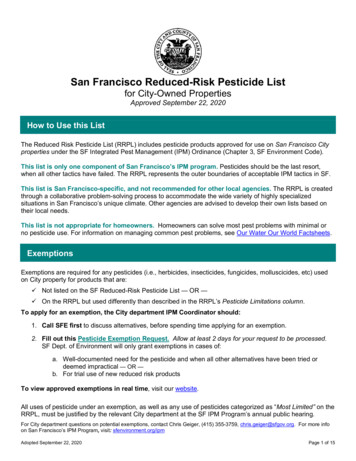
Transcription
San Francisco Reduced-Risk Pesticide Listfor City-Owned PropertiesApproved September 22, 2020How to Use this ListThe Reduced Risk Pesticide List (RRPL) includes pesticide products approved for use on San Francisco Cityproperties under the SF Integrated Pest Management (IPM) Ordinance (Chapter 3, SF Environment Code).This list is only one component of San Francisco’s IPM program. Pesticides should be the last resort,when all other tactics have failed. The RRPL represents the outer boundaries of acceptable IPM tactics in SF.This list is San Francisco-specific, and not recommended for other local agencies. The RRPL is createdthrough a collaborative problem-solving process to accommodate the wide variety of highly specializedsituations in San Francisco’s unique climate. Other agencies are advised to develop their own lists based ontheir local needs.This list is not appropriate for homeowners. Homeowners can solve most pest problems with minimal orno pesticide use. For information on managing common pest problems, see Our Water Our World Factsheets.ExemptionsExemptions are required for any pesticides (i.e., herbicides, insecticides, fungicides, molluscicides, etc) usedon City property for products that are: Not listed on the SF Reduced-Risk Pesticide List — OR — On the RRPL but used differently than described in the RRPL’s Pesticide Limitations column.To apply for an exemption, the City department IPM Coordinator should:1. Call SFE first to discuss alternatives, before spending time applying for an exemption.2. Fill out this Pesticide Exemption Request. Allow at least 2 days for your request to be processed.SF Dept. of Environment will only grant exemptions in cases of:a. Well-documented need for the pesticide and when all other alternatives have been tried ordeemed impractical — OR —b. For trial use of new reduced risk productsTo view approved exemptions in real time, visit our website.All uses of pesticide under an exemption, as well as any use of pesticides categorized as “Most Limited” on theRRPL, must be justified by the relevant City department at the SF IPM Program’s annual public hearing.For City department questions on potential exemptions, contact Chris Geiger, (415) 355-3759, chris.geiger@sfgov.org. For more infoon San Francisco’s IPM Program, visit: sfenvironment.org/ipmAdopted September 22, 2020Page 1 of 15
San Francisco Reduced-Risk Pesticide Listfor City-owned propertiesProduct NameTypeEPA #/SF Type***Use LimitationsOther uses require an exemptionGENERAL USE PRODUCTSActinovate productsFungicide73314-1, 524- Streptomyces lydicus641WYEC 108Leasthazardous(Tier III)Least LimitedAdvance 360A DualChoice Ant BaitStationsInsecticide499-496abamectin B1, 0.011%Mosthazardous(Tier I)Least limitedAdvion Ant GelInsecticide100-1498Indoxacarb 0.05%Advion Cockroach BaitArenaInsecticide100-1486Indoxacarb 0.5%Advion EvolutionCockroach Gel BaitInsecticide100-1484Indoxacarb 0.6%Agri-Fos SystemicFungicideAnt and crawling insectbaits - borate based self contained, gel,liquidAdopted September 22, 2020FungicideInsecticideLeasthazardous(Tier III)Leasthazardous(Tier III)Leasthazardous(Tier III)Least LimitedLeast LimitedLeast Limited71962-1Potassium phosphite45.8%Leasthazardous(Tier III)Least LimitedVariousBoric acid, sodiumtetraboratedecahydrate, or otherborate saltsMosthazardous(Tier I)Least LimitedFinal versionFor use on high-value Coast Live Oaks(Quercus agrifolia ) susceptible to Phytophthoraor in experiments with Phytophthora control, oron high-value Monterey Pines (Pinus radiata )susceptible to Fusarium subglutinas. Inaccordance with label restrictions for use inCalifornia, injection and basal bark spray is theonly application method permitted.Page 2 of 15
San Francisco Reduced-Risk Pesticide Listfor City-owned propertiesPesticideHazardTier**Product NameTypeEPA #/SF code*Aquatrols CapsilAdjuvant9037-50003Polyether ModifiedPolysiloxane, 20%Avenger Weed KillerConcentrateHerbicide92967-1d-Limonene 60%AxxeHerbicide70299-23Nonanoic acid, 61%IngredientsAzatrol EC InsecticideInsecticide2217-836Azadirachtin (2328)1.2%Bacillus thuringiensisinsecticides (excludingmosquito control)InsecticideVariousBacillus thuringiensis(various subspp.)BestYet CedarcideInsecticideexemptprod- Cedarwood oil,009amorphous silicaBioLink Buffer &PenetrantAdjuvantexemptprod- Citric acid 20%, garlic010extract 7%CambistatGrowthregulatorCimexa Insecticide Dust InsecticideAdopted September 22, 2020Leasthazardous(Tier III)Leasthazardous(Tier III)Morehazardous(Tier II)UseLimitationType***Use LimitationsOther uses require an exemptionLeast limitedAlternative surfactant to CMR productMore LimitedSubject to "Restrictions on herbicides."Burndown herbicide. Not for use near water.More LimitedSubject to "Restrictions on herbicides."Burndown herbicide.Morehazardous(Tier II)More LimitedFor greenhouses and established plants forinteriorscapes. Do not apply on flowering plantswhen bees are active. USE UP EXISTINGSTOCKS - NO LONGER AVAILABLE.Leasthazardous(Tier III)Least LimitedLeasthazardous(Tier III)Morehazardous(Tier II)74779-3Paclobutrazol, 22.3%Morehazardous(Tier II)73079-12Amorphous silica gel100%Leasthazardous(Tier III)Final versionLeast LimitedLeast LimitedMore limitedFor use only on Ficus trees in difficult to accesssites due to Muni overhead Lines, trackclearances, or similar restrictions that requiretransit modifications or disallow pruning duringnormal business hours.Least LimitedOnly for use on ants, rat mites, bedbugs, lice,and yellowjackets in walls when nonchemicaltechniques prove ineffective.Page 3 of 15
San Francisco Reduced-Risk Pesticide Listfor City-owned propertiesPesticideHazardTier**Product NameTypeEPA #/SF code*Clearcast HerbicideHerbicide241- 437Imazamox, ammoniumsaltCompetitorAdjuvant2935-50173Ethyl oleateIngredientsConserve SC Turf andOrnamentalInsecticide62719-291Coyote urine basedproductsMammalrepellantexemptprodCoyote urine014Debug ia IC3Adopted September 22, 2020InsecticideMorehazardous(Tier II)Leasthazardous(Tier III)Morehazardous(Tier II)Spinosad 11.6%Fats & glyceridic oilsmargosa 65.8%,azadirachtin 0.7%White pepper 3%, whiteexemptprodmineral oil 87%, silica01510%Rosemary oil 10%,geraniol 5%,exemptprod- peppermint oil 2%,013wintergreen oil, whitemineral oil, vanillin,polyglyceryl oleateLeasthazardous(Tier III)Morehazardous(Tier II)Leasthazardous(Tier III)Leasthazardous(Tier III)Final versionUseLimitationType***More LimitedUse LimitationsOther uses require an exemptionSubject to "Restrictions on herbicides."Least LimitedLeast LimitedFor use as a last resort in greenhouses. Iffeasible, alternate with other products to avoidthe development of resistance. Use on highvalue ornamentals only.Least LimitedLeast LimitedLeast LimitedLeast LimitedPage 4 of 15
San Francisco Reduced-Risk Pesticide Listfor City-owned propertiesProduct NameTypeEPA #/SF (Tier I)UseLimitationType***Use LimitationsOther uses require an exemptionSubject to "Restrictions on herbicides"Use only for targeted treatments of high profileor highly invasive exotics via dabbing orinjection. May use for targeted spraying onlywhen dabbing or injection are not feasible.USE UP EXISTING STOCKS (Vastlan is saferalternative)Garlon 4 UltraHerbicide62719-527Triclopyr, butoxyethylester 60.45%Havahart Critter RidderMammalrepellant50932-10Oil of black dropreneLifeline HerbicideHerbicide70506-310Glufosinate,ammonium, 24.5%Morehazardous(Tier II)More LimitedSubject to "Restrictions on herbicides."Maxforce CompleteGranular Insect BaitInsecticide432-1255hydramethylnon, 1%Mosthazardous(Tier I)More LimitedOnly for use in bait stations.Maxforce Impact RoachInsecticideGel Bait432-1531Clothianidin, 1%Least LimitedRotate active ingredients to manage resistanceMet 52 GranularBioinsecticide70127-8Metarhizium anisopliaestrain F52, 11%Least LimitedPreferred alternative to spinosad productsAdopted September 22, 2020InsecticideLeasthazardous(Tier III)Leasthazardous(Tier III)Morehazardous(Tier II)Leasthazardous(Tier III)Final versionMost LimitedLeast LimitedLeast LimitedPage 5 of 15
San Francisco Reduced-Risk Pesticide Listfor City-owned propertiesProduct NameMilestoneTypeHerbicideEPA #/SF code*PesticideHazardTier**IngredientsUse LimitationsOther uses require an exemption62719-519Aminopyralid, triisopropanolamine salt(5928) 40.6%Morehazardous(Tier II)More LimitedSubject to "Restrictions on herbicides." Forinvasive species in natural areas or parklandswhere other alternatives are ineffective,especially for invasive legumes and compositessuch as yellow star thistle and purple star thistle.Morehazardous(Tier II)More LimitedSubject to "Restrictions on herbicides." Useonly for cut stump or injectionLeast LimitedUSE UP EXISTING STOCK; Safer SoappreferredMilestone VM propanolaminesalt, 2%; Triclopyr,triethylamine salt, 16%M-pede productsInsecticide53219-6,10163-324Potash soap 49%Nibor-DInsecticide64405-8Disodium OctaborateTetrahydrate, 98%Imazapyr,isopropylamine salt,28%Nufarm exemptprodSodium lauryl sulfate002D-limonene (orange oil)5.8%Orange prodSesame oil 5%010Adopted September 22, 2020UseLimitationType***Morehazardous(Tier II)Mosthazardous(Tier I)Least limitedMorehazardous(Tier II)More LimitedLeasthazardous(Tier III)Least LimitedMorehazardous(Tier II)More LimitedLeasthazardous(Tier III)Least LimitedFinal versionSubject to "Restrictions on herbicides."Alternative to Tier I herbicides. Use caution withadjoining desirable vegetation.Soap spray is preferred for removing ant trails.Minimize use in enclosed areas due to scent.Potential aquatic hazard - do not apply directly towater.Page 6 of 15
San Francisco Reduced-Risk Pesticide Listfor City-owned propertiesProduct NameTypeEPA #/SF code*Oust XP Herbicide(DuPont)Herbicide352-601Pentra-bark BarkPenetrating SurfactantAdjuvantPolyalkyleneoxide83416-50001 e***Morehazardous(Tier II)Most LimitedLeasthazardous(Tier III)Least LimitedUse LimitationsOther uses require an exemptionSubject to "Restrictions on herbicides." Foruse only on airport operational areas subject toFAA requirements, or PG&E leased yards.499-362Phenothrin .12%,d-trans allethrin .129%,CO2Mosthazardous(Tier I)Most LimitedUse only when a concern for public safety, andin situations where use of soap-based products,Suspend, or physical removal is inadequate orunsafe.Roundup CustomHerbicideHerbicide (Aquamaster)524-343Glyphosate,isopropylamine salt53.8%Mosthazardous(Tier I)Most LimitedSubject to "Restrictions on herbicides."Safer Soap OInsecticidal SoapConcentrateInsecticide42697-60Potassium laurate,49.52%Morehazardous(Tier II)Least LimitedSluggo Slug and SnailBaitMolluscicide67702-3Phosphoric acid,iron(3 ) salt (1:1) 1%Spraytech OilInsecticide65328-50001 Soybean oilSuppress Herbicide ECHerbicide51517-9Prescription TreatmentBrand Wasp-FreezeWasp and Hornet KillerAdopted September 22, 2020InsecticideCaprylic acid, 47%;capric acid, 32%Leasthazardous(Tier III)Morehazardous(Tier II)Morehazardous(Tier II)Final versionLeast LimitedLeast LimitedLeast LimitedSubject to "Restrictions on herbicides."Alternative to Tier I herbicides. Burndownproduct.Page 7 of 15
San Francisco Reduced-Risk Pesticide Listfor City-owned propertiesProduct NameSuspend PolyzoneVastlanTypeInsecticideHerbicideEPA #/SF code*PesticideHazardTier**IngredientsUse LimitationsOther uses require an exemptionMost limitedRestricted to treatments of stinging insect nestsin highly public areas, where slower-workingalternatives could result in hazards to the public.May also be used for carpenter bees at CampMather when preventive measures have failedTriclopyr choline,45.2%; glycerol, 3%Morehazardous(Tier II)Most limitedSubject to "Restrictions on herbicides"Use only for targeted treatments of high profileor highly invasive exotics via dabbing orinjection. May use for targeted spraying onlywhen dabbing or injection are not feasible.Leasthazardous(Tier III)Least LimitedLeasthazardous(Tier III)Least LimitedDeltamethrin, 4.75%Mosthazardous(Tier I)62719-687432-1514UseLimitationType***Weed Slayer AgroGoldHerbicideTBDEugenol 6.0%; waterand molasses 94%.Mixed with BacillusmegateriumZoecon PreCor IGRConcentrateInsecticide2724-352S-Methoprene, 1.2%;mineral oil, refined,98.8%WEED SLAYER/AGRO GOLD REMOVEDFROM LIST 12/8/2020 DUE TO STATEQUARANTINE - DO NOT USE!GOLF PRODUCTSCivitas Turf Defense PreFungicideMixed69526-17Mineral oil, refined,89%Leasthazardous(Tier III)Least LimitedFosphite FungicideFungicide68573-2Potassium phosphateLeasthazardous(Tier III)More LimitedOnly for use on golf courses.Heritage FungicideFungicide100-1093Azoxystrobin 50%Mosthazardous(Tier I)Most LimitedFor use on Harding Park/Fleming golf coursesonly in preparation for tournament playAdopted September 22, 2020Final versionPage 8 of 15
San Francisco Reduced-Risk Pesticide Listfor City-owned propertiesProduct NameTypeEPA #/SF Type***Use LimitationsOther uses require an exemptionMore LimitedSubject to "Restrictions on herbicides." Foruse on Harding Park/Fleming golf courses onlyin preparation for tournament play. May be used1x/year in other golf courses on greens only.62719-305Clopyralid, 40.9%Morehazardous(Tier II)Primo trahydrofurfurylalcohol (THFA)Morehazardous(Tier II)More LimitedOnly use on Harding/Fleming golf courses inpreparation for major golf tournaments.Quinclorac 1.5LHerbicide53883-336Quinclorac,dimethylamine salt,18.92%Morehazardous(Tier II)More LimitedSubject to "Restrictions on herbicides." Foruse on Harding Park/Fleming golf courses onlyin preparation for tournament play.RhapsodyFungicide264-1155QST 713 strain of driedBacillus subtilis, 1.34%Leasthazardous(Tier III)Least LimitedLontrel Turf andOrnamental eTrimmit 2SCGrowthregulatorAdopted September 22, 2020More LimitedSubject to "Restrictions on herbicides." Onlyuse on City-owned golf courses in preparationfor major golf tournaments, or for pilot testingelsewhere as a glyphosate alternative.Mosthazardous(Tier I)More LimitedFor management of pink snow mold(Microdochium nivale) on Harding Park/Fleminggolf courses only in preparation for tournamentplay.Morehazardous(Tier II)More LimitedFor use only on golf courses in preparation fortournament play.62719-547PenoxsulamMorehazardous(Tier II)59639-144Metconazole, 50%;Silica-crystalline quartzPaclobutrazol 22.3%100-1014Final versionPage 9 of 15
San Francisco Reduced-Risk Pesticide Listfor City-owned propertiesProduct NameTrinity FungicideTurflon EsterTypeFungicideHerbicideEPA #/SF entsTriticonazole, 19.2%Mosthazardous(Tier I)Triclopyr, butoxyethylester 61.6%Morehazardous(Tier II)UseLimitationType***Use LimitationsOther uses require an exemptionMore LimitedFor use on Harding Park/Fleming golf coursesonly in preparation for tournament play. May beused 1x/year in other golf courses on greensonly.Most LimitedSubject to "Restrictions on herbicides."Subject to "Restrictions on herbicides".Targeted treatment of golf course turf.Quinclorac should be the first option. HIGHPRIORITY TO FIND ALTERNATIVE.VECTOR CONTROL PRODUCTSAgnique MMFMosquito53263- 30control - droxy-phosphate32%ContrapestRodent91601- 1contraceptiveTriptolide, 0.001%; 4vinyl cyclohexenediepoxide, 0.1%Mosthazardous(Tier I)10551-1Carbon, 9%; Sodiumnitrate, 50%; Sulfur,38%Mosthazardous(Tier I)VariousBacillus thuringiensis(Berliner or Israelensis)or Bacillus sphaericusLeasthazardous(Tier III)Giant Destroyer (smokeRodenticidebomb)Mosquito control microbialAdopted September 22, 2020Mosquitocontrol microbialMorehazardous(Tier II)More LimitedUse for late instar mosquito larvae and pupae, incombination with microbial products. USE UPEXISTING STOCK - NO LONGER SOLDLeast LimitedFor long term reductions in rat populations.Most LimitedAlternative to baits for rodents in burrows.Observe label limitations on endangeredspecies and potential for human smokeexposure. Not for use beneath or adjacent tostructuresLeast LimitedAny microbial mosquito larvicide with activeingredients Bacillus thuringiensis (Berliner orIsraelensis) or Bacillus sphaericus iscategorized as Least limited.Final versionPage 10 of 15
San Francisco Reduced-Risk Pesticide Listfor City-owned propertiesProduct NameTypeEPA #/SF Type***Use LimitationsOther uses require an exemptionMosquito controlproducts - IGRsMosquitoVariouscontrol - IGRsS-Methoprene (5026Leasthazardous(Tier III)More LimitedUse for tanks with limited access, or other areaswhere frequent treatments are infeasible. ForCity catchment basins, microbial products arepreferred. Not for use in estuarineenvironments except under control of SanMateo Mosquito Abatement District.Mosquito controlproducts - oilsMosquitoVariouscontrol - otherHighly refinedpetroleum distillate(mineral oil) - noaromaticsMorehazardous(Tier II)More LimitedUse as a pupacide for public health mosquitotreatments.Rat IceRodenticideCarbon dioxideMorehazardous(Tier II)More LimitedCholecalciferolMorehazardous(Tier II)Rodent control cholcalciferol blockbaitsRodent control diphacinone baitsAdopted September 22, 2020RodenticideRodenticide12455- 148VariousVariousDiphacinoneMorehazardous(Tier II)Final versionMore LimitedSee Site-Specific Limitations. For commensalrodent control only in situations with high publichealth concerns, where trapping is infeasible. Inall cases, monitoring shall be used wheneverfeasible to minimize rodenticide use.More LimitedSee Site-Specific Limitations. For rat controlonly in situations with high public healthconcerns, where trapping is infeasible. Burrowbaits not permitted in parks. In all cases,monitoring shall be used whenever feasible tominimize rodenticide use. HIGH PRIORITY TOFIND ALTERNATIVE.Page 11 of 15
San Francisco Reduced-Risk Pesticide Listfor City-owned propertiesProduct NameTop Gun All WeatherBait Block RodenticideTypeRodenticideEPA #/SF thalin 0.01%Mosthazardous(Tier I)Use LimitationsOther uses require an exemptionUseLimitationType***Most LimitedFor use only in City-owned sewer lines, SanFrancisco International Airport Terminal Areas,or for commercial lessees on city properties thatare not adjacent to natural areas. In commercialestablishments, use of product shall be a lastresort after other, less-toxic measures havebeen implemented, including sanitation andtrapping, and only where a significant publichealth hazard is recognized by the SanFrancisco Dept. of Public Health. In all cases,monitoring shall be used whenever feasible tominimize rodenticide use.*For products exempt from US EPA registration (usually 'Generally Regarded as Safe'), SF creates its own product code**A product's tier ranking reflects hazard (the possibility of harm) but not risk (probability of harm). It is does not includeconsideration of likely exposure. Tier rankings determined using the SF Pesticide Hazard Screening se limitation type is an informal rating of risk (probability of harm), determined by considering a product'shazard tier rating, formulation, likely exposure, and typical uses. Applications of"most limited" pesticides must be justified at an annual public hearing.Adopted September 22, 2020Final versionPage 12 of 15
San Francisco Reduced Risk Pesticide List:Restrictions on Herbicides for City PropertiesBackgroundThe use of chemical pesticides is always a method of last resort in San Francisco’s Integrated Pest Management(IPM) Program. The Reduced Risk Pesticide List and these accompanying restrictions below were created in apublic process by the San Francisco Department of the Environment in close consultation with affected City &County of San Francisco departments, in keeping with the Precautionary Principle and Integrated PestManagement ordinances (Environment Code, Chapters 1 and 3). Any other uses of herbicides require anexemption granted by the San Francisco Department of the Environment.Goals1. Reduce the use of herbicides to those situations where they are only used in situations critical to publichealth, public safety, and protection of major public assets, including biodiversity assets.2. Ensure that the restrictions are attainable through continued collaboration among City IPM staff.3. Minimize potential harm to the environment, City workers, and the general public from any pestmanagement activities, in keeping with the Precautionary Principle.4. Maximize the ability of city residents to know when and where pesticides are being used.A. Conditions of use - ALL HERBICIDESRequirements1. All treatments must be posted as per City ordinance (Env Code §304). All postings must clearly identify thearea to be treated. Postings should be placed in location(s) most likely to be seen by users of the treatedarea.2. Blue indicator dyes must be used for spray treatments. The use of blue dye must be noted on the posting.Dye must be mixed at a concentration that makes it clearly visible.Exceptions:a. Blue indicator dye is not required on golf courses, hardscapes, or in cases where posting is nototherwise required.3. For treatment sites that cannot be readily described using the posting sign alone, a map showing thegeneral location of expected treatment area(s) must be attached to the posting sign.4. Contractors must be fully briefed and trained in, and implement the San Francisco IPM program’sordinance, requirements and policies.5. All uses must comply with the California Red-legged Frog Stipulated Injunction.6. No use on plants with edible berries when ripe fruits are present.7. No use on green roofs or green wall features.B. Conditions of use - TIER I HERBICIDESTier I (“Most Hazardous”) herbicides are subject to Conditions of Use for “ALL HERBICIDES” list above, plusthe following:Requirements8. Any application of ‘most hazardous’ herbicides on City property within the City limits or at San FranciscoInternational Airport must be under the direct supervision of a licensed person. A licensed person isdefined for these purposes as a person possessing either an Agricultural Pest Control Advisor license, aQualified Applicator License, or a Qualified Applicator Certificate issued by the California Department ofPesticide Regulation. “Direct supervision” means that the licensed person must be physically present atthe site of application.9. Within the City limits, when ‘most hazardous’ herbicides are used on publicly accessible parcels, eitheraccess to the treatment area must be blocked or a physical demarcation must be set up around thetreatment area. Acceptable physical demarcations include fencing, rope, tape, or staked plastic cones.Exceptions:a. Golf coursesb. Street mediansAdopted September 22, 2020Page 13 of 15
c.Areas managed for habitat conservation10. No use for purely cosmetic purposes.11. No use on the grounds of or within 15 feet of the boundaries of schools, preschools, childrens’playgrounds and other areas frequented by children.12. No use within 15 feet of designated, actively maintained public paths. “Designated public paths” arewalking paths that appear on City maps. If maps do not exist, then “designated public paths” means pathsthat are actively maintained by City operations.Exceptions:a. Areas falling under state or federal vegetation management requirements, including utility rights ofway and easements, dams, reservoir embankments, and watershed lands.b. Cases where alternative control methods pose a significant public safety, public health or fire risk,for example, poison oak along popular trails.c. Street median strips.d. Trails that have been closed to public access, with informative signage (see #1) and physicalbarriers (see #8).13. No broadcast spraying using a spray boom is permitted. Use of a backpack sprayer is not consideredbroadcast spraying, provided that the applicator is targeting specific plants that have been identified fortreatment.Exceptions:a. Targeted treatments at Harding Park golf course in preparation for tournament play.Adopted September 22, 2020Page 14 of 15
Site-Specific Limitations on Rodenticide UseUpdated 9/24/19Rodenticides are always a last resort. Due to the concern over primary and secondary poisoning, the type of rodenticideand the manner in which it is applied will be determined by the general site characteristics.DEFINITIONS:Natural area:Landscape area managed primarily for habitat, or managed for other uses (such asrecreational or aesthetic uses) but likely to harbor significant populations of mammal or birdwildlifePrimary poisoning:Non-target animal eats poison directlySecondary poisoning:Non-target animal eats poisoned target animal as preySingle-feed baits:Baits with bromethalin, brodifacuom, bromodialone, difenacoum, difethialone activeingredients.General Site DescriptionConditions Where Rodenticide Use is PermittedInside of sewers or sewage treatmentfacilities:Baits must be secured either inside the sewer or inside a baitbox. Single-feed baits permitted. Monitoring with non-toxicbaits encouraged.Commercial enterprises (such asrestaurants) on leased City propertiesTrapping preferred. Use of single-feed baits shall be a lastresort after other, less-toxic measures have beenimplemented, including sanitation and trapping. Exemptionrequired for any single-feed baits, and only where a significantpublic health hazard is recognized by the SF Dept. of PublicHealth.Interior of structures with occupants (i.e.office space, recreation sites)Trapping only.Interior of non-enclosed structuresTrapping preferred. Secure and anchored bait stations can beplaced inside on a preventative basis. No single-feed baits.(i.e. storage, stables, airport service areas) –not adjacent to natural areas.Exterior of structures in urbanized areas(i.e. perimeter of offices)Trapping preferred. Secure and anchored bait stations can beplaced inside on a preventative basis. No single-feed baits.Exterior of structures in natural areasMultiple feeding baits may be used only as last resort in caseof human health concern or structural integrity. Baits must besecured within bait boxes or buried in burrows. No singlefeed rodenticides.Landscape not adjacent to a natural areaBait placed deep inside burrows, or secured inside bait boxes.Minimize use of pellets, mouse sized pellets only, must beburied deep in the burrow. No single-feed baits.Natural area or landscape adjacent to anatural areaMultiple feeding baits may be used only as last resort in caseof human health concern or structural integrity. Baiting shouldbe limited to sensitive sites such as campfire areas, or onpreventing infestation of structures. Baits must be securedinside bait boxes or burrows. No use of pellets or singlefeeding rodenticides.Adopted September 22, 2020Page 15 of 15
The Reduced Risk Pesticide List (RRPL) includes pesticide products approved for use on San Francisco City properties under the SF Integrated Pest Management (IPM) Ordinance (Chapter 3, SF Environment Code). This list is only one component of San Francisco's IPM program. Pesticides should be the last resort, when all other tactics have failed.
